Introduction
David Tai
History:
10 years old Tai was fall 5miters from the tree, lesion to left side of the body, T7 ribs, pelvic and temporally lost consciousness. Tai damaged L3-4 dislocation-subluxation, thrown javelin paraplegia in 1949, and at home accidence in bathroom, lesion to C7-T1 fracture and subluxation Quadriplegia in 1987, right finger between index and thump interosseous muscle atrophied.
That is Tai learning Western medicine and Acupuncture try to treating his body less disable, live and walk independently, now Tai is 87 still practicing acupuncture for Tai and SCI patients.
Following are Tai from 1979 to 2019 in Australia treating Quadriplegia and paraplegia SCI cases study.
Ben Quadriplegia
Abstract
Purpose: To develop and evaluate acupuncture and neuroscience approach to spinal cord injury to maximize residual functional capacity and minimum disability.
Acupuncture Methodology:
SCI is a complex damage to the nervous system, essentially, is injured to the spine, spinal cord, upper and lower motor neurons, spinal nerve, in which lost of skin sensation, muscles movement, and internal organs-such as lost urination, bowel movement and sexuality function.
Acupuncture is one form of medical treatment for SCI. The methodology is applying neuro-science, and needle techniques achieved the result.
The three sets GV, Huatoujiaji, and BL meridian points on the spine-Back Shu points, four sets CV, KI and ST+SP points on the Chest-Front Mu points, upper and lower limbs Five Shu points. Fire burning the mountain-Pure Reinforce method is applies.
The differentiation in this study:
The major points of difference in this approach is: the utilization of different strengths of acupuncture needle application which incorporates three effects: Receptors stimulation (strong medium and gentle), cellular repair (blood and QI), and utilization of the acupuncture needle-sharp, which performs like a scalpel to release and stretch the scar tissue and muscles following the initial needle insertion point has been made.
The second point of difference is the utilization of the acupuncture needle by multiple needle insertion within the body, which produces nerve impulses as a strong wave vibration, which pass through sensory and motor gates and the neurotransmitter that transmits from one neuron to other neuron, which rebuilding reflex components.
Repeat needling into the points can induce inflammation and wounding of the tissue to recruit macrophages into the region and to induce local inflammation cellular for SCI wound healing.
This treatment protocol is offered as 3 sessions/week lasting one hour, over 3 to 6 years post-injury.
Conclusions: Our approach is based on maximizing the patients’ own repair processes by maximizing bone marrow derived macrophage recruitment; stimulation of local populations of stem cells and utilization of the acupuncture needle to stimulate key neurological networks above and below the spinal cord lesion. With the aim of maintaining/providing neurological input on neural networks that would otherwise receive limited stimulation. This case study report demonstrates that western medicine combined with acupuncture methodology significantly enhances functional recovery beyond current available rehabilitation methodology and physiotherapy in SCI.
Ps: in the pass thirty years, Tai had treating SCI—8 cases Quadriplegia and 7 cases Paraplegia Patients, at that time more involved clinical practice requirement, in this book, the last discussion of the preview cases, will pay more attention on analysis the treatment progress.
Definition of Acupuncture
Acupuncture refers to the insertion of a fine filiform needle into key point on the body to treat illness. Points are located in the tissues of the body’s wall. The needle is inserted into body wall tissues through different channels largely are via the nervous system, activated the body potential and strength to heal the illness. Dependent on where the illnesses required, ACU point is located, the practitioner is inserted the needle target on the illnesses and the correlated point in which is located into the skin, into the connective tissues, muscles or joints, even deep into the periosteum of the bone. Only in the rare cases would a skilled practitioner target an internal organ. In most acupuncture practice is through reflexes mechanism achieves the result, not of necessity having to needling into the organ directly. Traditionally, the sharp tip of needle does not carry any medication or herbs.
SCI Diagnosis
ACU clinical diagnosis of SCI utilizes the American Spinal Injury Association standard based on neurological examination, MRI and/or CT scans, as well as the hospital diagnosis at discharge.
Quadriplegia cases study
Ben—Quadriplegia
Name: Benjamin Tillman
Date of birth: 9/2/1987
Male
Date of accident: 27/10/2012
Date of initial acupuncture treatment: 12/1/2013.
https://m.huffingtonpost.com.au/2015/08/29/learning-to-walk-again_n_7980408.html
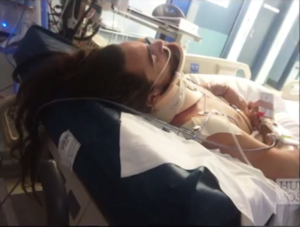
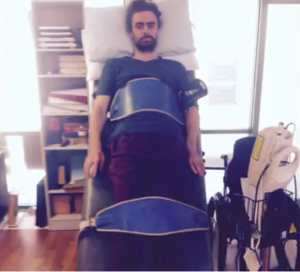
Diagnosis:
- Ben was in a severe motor vehicle accident
overstretched flexion and extension of the head and neck
cause lesion to the medulla and brainstem neural pathway.
- MRI and CT scan report showed C5-6-7 cervical vertebrae fracture and cord injury
- Clinically Ben was diagnosed C7 (neurological level) ASIA B
MRI
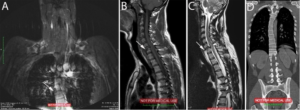
Fig 1. Ben’s X-ray images: just after injury (10/2012)
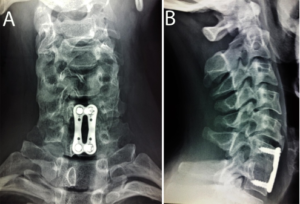
Fig 2. Ben’s X-ray images: 4.5 years after injury (16/5/2017)
Bens’ X-ray study:
The lesion in cervical vertebrae involved C1 to C7 Fracture, compression, and T1 to T12 spine curvature, the spinous processes fracture, the involved ligament thickness.
After SCI, Ben had neck operation, the crusted attempt stability of the C4, 5, and C6, neck position.
Clinically shows head neck and upper chest and back muscles contraction and vertebral column instability. The results of fracture on vertebrae associated with Red nucleus—brainstem damage; show more severe muscle contraction and extremities spasticity. After SCI, Ben attempt strenuous exercises to achieve the recovery, the outcome become more complicated, the leg spasticity come and go, and more frequency, after body movement.
Three years after accidence, and ACU treatment, Ben can stand and walk well with walking frame, it seems Ben achieve good outcome and match to ASAS—American spinal cord injury association standard, Ben continue ACU treatment, want to walk independently.
Table 1. Ben’s lower limb motor power
________________________________________________________________ 10/10/12 23/1/13 30/3/17
L R L R L R
Hip flexion 0 0 0 0 4 4
Extension 0 0 0 0 4 4
Abduction 0 0 0 0 4 4
Adduction 0 0 0 0 4 4
Opposition 0 0 0 0 4 4
Knee flexion 0 0 0 0 3 3
Extension 0 0 0 0 3 3
Ankle flexion 0 0 0 0 1 1
Extension 0 0 0 0 1 1
Foot flexion 0 0 0 0 0 0
Extension 0 0 0 0 0 0
Toe flexion 0 0 0 0 0 0
Extension 0 0 0 0 0 0
________________________________________________________________
L: left, R: right
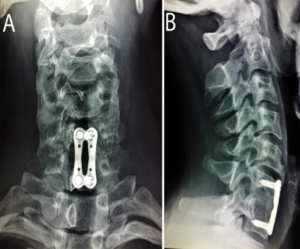

Ben cervical vertebrae C3 left subluxations, C4, C5, C6, C7 vertebral column, spinous process fracture and subluxation, the post operation screw shows.
Post operation scars on the neck, the scars are not situated on the centre, more on left site cross the sternocleidomastoid muscle, and shows the following side clavicular bone rising. The scars causing neck and head imbalance of the cervical vertebrae movement, especially, after removal of the screw, show the body symptoms, spasticity, sleep difficulty to keep the head position and weakling up headache. Ben after operation asking the surgeon how that going? The answered was ‘see three months after operation’, after operation; Ben still sit on wheelchair, had neck pain and difficulty in sleep.
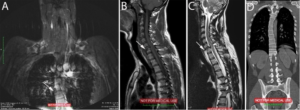
Those four pictures show Ben had acute and chronic damaged on his vertebrae and pelvic, picture-D, initial T1 to T4 vertebrae fracture and subluxation, from T4 to T12 spine curvature.
Ben car vehicle accident was drunken driving, severed head and neck flexion and extension, right site back muscles contraction and left site flatten. Direct impact to spine causing vertebrae fracture dislocation compression and curvature, the severed head and neck flection and extension, also lesion to Brainstem and medullar oblongata neural pathway.
ACU treatment
Ben interest with acupuncture, that was no another choice, he was frightening the needle, especially, needling to the neck and head, and here is the essential lesion part.
Ben confident with Tai; that is a hope, and Tai demonstration his paralysed legs moving—reflex activity.
In one year, ACU treatment Ben can stand, two three years after, Ben can walk with walking frame hundred meters, but Ben does not feel ACU treatment had improvement, because he feels when he is walking just like flying on the air, that mean: he not necessary is walking. Lucky enough Ben keep coming for ACU treatment and Tai do what he can. Ben believed that one day soon he can walk independently.
The immediate treatment is released the urgent symptoms:
Musculature contraction on the back of the scapular, stiffness of the neck, hands and legs spasticity…
The essential treatment focus on:
Motor central nuclei pathway lesion
Neck and head lesion
Spine—Cervical and thoracic vertebrae
Spasticity
Regain skin sensation and muscles movement
Training stretching, the thigh, leg and feet, walk with walking frame, crutches, stick and independent walking.
1-1. The Red Nucleus
The syndrome of lesion to the red nucleus; essentially, reveal the symptom of pectoralis contraction, in scapular region, posterior superior serratus, rhomboid major and minor, trapezius, arm and hand muscles, fingers flexion spasticity.
Ben car accidence show chest and upper back muscles contraction, arm, hand stiffness, and fingers spasticity, that is means lesion to Red nucleus. ACU treatment is focuses on release muscles contraction, especially, the distal extremities spasticity, when extremities spasticity is stop, the muscles symptom is released the lesion in Red nucleus is recovery.
ACU points selection:
- Pectoralis: Points selection: LU1-2, ST15-16-17, KI22 KI24, CV3-15-22.
- Biceps: ACU point LI15, and LU5 PC3.
- Posterior Superior Serratus, Rhomboid, Trapezius muscles and tendons: BL 41 to 47 on the edge of spine of the scapular and points on vertebral column BL11 to BL18. Method: gentle needling and 15 minutes needle retention to reduces the muscles contraction, strong needling to excitation the weaken muscles. After needling gentle stretching the upper chest and back muscles.
In treating Ben needs focus on the cervical vertebrae, GB20-21, BL11, GV14 and JIAJI points on C6, C7, and T1. When muscle flexion spasticity reduce, that included finger, arm, chest and back, and Ben hands feel more strength.
Right-side shoulder and back of spine muscles strong contraction, and left-side muscles flatten. ACU treatment reinforcements the left muscles and reduction of the right muscles, and avoid doing strenuous-exercises, of the back and chest, prevention of spine curvature.
1-2. Reticular Formation
Reticular formation is a set of interconnected nuclei that are located throughout the brainstem, which is a neural pathway connected brainstem to motor central nuclei, and down to spinal cord motor neurons.
The needle insertion, Moxa heat and massages to the skin, muscles spindles, joint capsules or periosteum receptors; stimulates the fingertips, body trunk and extremity points may via spino-reticular tracts, spino-thalamic tracts ascending to motor cortex, the results pass through reticulo-spinal descending tracts and effect the motor neurons maintaining tone, balance, and posture, especially during body movements.
Vestibulospinal tract assist the reticular formation to maintain muscle tone and balance the body’s posture, so when patient standing and walking needs to keep the head up and eyes looking forward in a straight position.
ACU treatment for reticular formation:
- Needle insertion stimulates the fingertips, body trunk BL meridian points and the points on extremity, body most of ACU points are cooperated with Reticular formation.
- Moxa stick heats the point for temperature stimulation, especially in winter or/and weakness of the body part that affect to Brainstem.
- Breathing exercises affect the breathing centre (in brainstem) and increase reflex activity, blood and lymphatic circulation.
- Scratching and stretching increased blood flow, joint, muscle and tendon activity.
- Combining methods may apply, ACU point selection and needle techniques and associated different methods increase blood flow and stimulation activate the Reticular formation neural network activity, recently, believed in human body, that Red nuclei and Reticular formation form a system, in which largely influences to ACU treatment perception.
1-3. Medulla Oblongata
Trauma in the anterior median fissure and pyramidal tracts the sensation cannot get through the olive medulla, then the cortico-spinal tracts cannot send the motor signal to the spinal cord and thus motor movement is impaired. Emergency treatment, ACU point selection: GB20 BL10 TB17 TB 16 GV15 GV16. The main aim is reducing edema at anterior median fissure. GV Huatoujiaji and BL meridian points targets on trapezius, scalene, rhomboid minor or major and levator-scapula muscles. ACU points GB21 GV14 BL11 BL41TB14 and TB15.
Treatment on the neck, there is a scar tissues on the throat at Adam level, needling the points surrounding on the scar and into the central of scar.
Point selection: LI18, ST5, ST9, ST11, CV22, CV23, TB17
Point below the mandibular ST6 ST7
The metal in cervical vertebrae is for stability the neck movement, the location is on C5-6-7 in which is bass of the neck, together with lesion to C8-T1, the neck movement is affected to the neck and spinal cord, particularly, Ben in deep sleep at night and a strong leg muscles contraction when Ben wake up at early morning, only after removal the metal, and continue ACU treatment slowly no more leg trembling.
Activated Breathing Potential
- Phrenic nerve—C3-4-5, and the nerve distribution pathway, Vagus neural path initial ear foramen distributed to xiphoid in which is along the side of the sternomastoid muscle and sternum inter-costal joints distributed into abdominal organs.
- Sternum to Xiphoid, initial CV22, the first rib and down, that involve the rib cage joints KI points, muscles ST, SP points. That is called: The front four sets of meridian points-on the chest and abdomen.
- The back three sets of meridian points on spine are JIAJI, GV and BL meridian points.
- Lateral of the rib X,XI, and XII, points selection: SP16 to SP21 GB24, GB25 Liv14.
- In Chinese version ‘QI-Kung’ exercises can maintain wellbeing. The thoracic cage and thoracic vertebral column are a strong and stable structure to maintain body posture and spine. The Chinese breathing exercises QI-Kung is focused on the QI—the respiration, using inspiration and expiration muscles and diaphragm, stretching the chest and abdominal wall muscles: to strengthen the thoracic wall muscles, to improve the coordinated muscles movement of the body front and back, rib cage and the thoracic vertebral column to stabilized the spine.
Actually, the results of the breathing exercises are more than external musculature reaction in which included increases the internal organ’s function, in particular, the neurovascular pathway, which is involved on diaphragm, neck, head, the lungs and the heart region blood circulations and the nervous system function. The breathing also actively mobile and massage the internal organs—liver, spleen, stomach, intestines and kidney. The body musculature moves the body part and naturally and powerfully move the body lymphatic and blood circulations.
Spinal cord and spinal nerves, especially, the lower thoracic and lumber vertebrae are directly involved the lower extremities skin sensation and muscles movement Without muscle movement the tendon on the ankle and legs will lack of blood supplies may loss function or atrophy. The lymphatic and blood circulation will stasis or loss; and the ankle and legs may swell. The old ageing process is starts from the legs—Chinese version. If does not move the legs will sit on wheelchair the real-life value is gone.
The breathing exercises fundamentally involved the respiration muscles. The clinical observation, frequently, the interruption is on ACU points: CV22 CV15 CV16 GB25 GV6 BL20 BL50.)
1-4. Chest and Abdominal wall muscles points
There are four sets of chest meridian points can be selected CV, KI, ST, and SP.
Pectoralis contraction ACU points: LU1 SP20 PC1 ST16 ST17 KI24.
Sternum and costal joint: CV and Kidney points on the chest.
Abdomen muscles points: ST 19-23-25-27-29, CV3-4-12-14, SP12,13-14-16, GB25-27-28, LV14, and KI11,2,13 KI22.
1-5. Thigh
- Major points are on the lumber-sacral plexuses such as BL22, 23, 25, 26 and BL50,51,52 on sacrum BL27 to BL34, BL53 and, BL54.
- Tendons and muscles linking point such as tensor fascia latae with gluteus maximus fascia and iliotibial tract with vastus lateralis ACU point GB30 GB31 GB32 GB33.
- Muscles attachment surrounding the greater trochanter and hamstring muscles. ACU points: BL35, 36, 37, 38, 39, 40.
The right thigh affected to motor central nuclei, chronic muscles spasticity caused chronic inflammation on the muscle attachment to the bone or joint. Ben SCI mainly lesion to brainstem upper motor central nuclei, when Ben mobile head, neck or body trunk immediate shows right leg spasticity. Thus, Ben thigh and right leg muscles are larger than the left, however, when walking the left leg moving and walk better than the right. If Ben head or/and neck on incorrect position; not maintain on straight position Ben difficult control the right leg moving. Beside needling correct the neck scars tissues and maintain head neck straight position, repeat and slow walking retrain; balance the cerebellum, reticular and cortex function. Obviously, after removal the metal in the cervical vertebrae leg and body trembling reduce obviously.
The chronic inflammation in trochanter and hamstring muscles attached to the tuberculosis and back of the knee tendons, must release inflammation rapidly, and excitation the muscles got the strength for stand. The point is palpated where the muscles are tightening and needling releases it.
1-6. Spinal nerve, sympathetic and parasympathetic nerve
- Most of SCI patients have lost the function of urination, sexuality and bowel movement.
- The points selection involved Vagus CNX, BL23,24,25,28,32, GV1,2,4, Huatoujiaji on L3 and L5 vertebrae level. Sacrum on S3 and S4 foramen BL meridian points.
- Abdominal points included CV1,2,3, KI11,12, ST25,28,29.
1-7. Five-SHU points on the leg
Needling Five Shu points improve the strength of the legs, Ben left leg more involved lower motor neurons, however, right leg may consideration treating motor central nuclei, particularly, needling to the points in plantar KI1, Jing-Well points and tendons of the foot, needling show leg strong reaction. After needling need doing stretching exercises. ACU treatment for lower extremities are strongly focused on extension and flexion coordinated muscles movement, passive and active movement of the leg. When patient can stand need special training stand straight head up, lock the knee and relax the trunk and body, more training of walk with walking frame, once or twice per day.
The thigh muscles are tone can lift the thigh up to the pelvic, need needling to the lateral side of the body, and asking patient used abdominal and thigh muscles move the leg included knee and ankle joints. In this stage, patient can train walk with walking frame. Few months after the leg’s muscles getting more strength can walk confidently and try to walk with crutches, that still need well training and avoid accident, if the sensation reaches to the foot and legs muscles more strength and coordinated movement. Slowly, the participant can walk with walking stick.
Ben is happy to the whole ACU treatment progresses in which take times achieve the results. When you have severed accidence, you need times and patience face to the truth, ACU treatment slowly get better both patient and practitioner need paid good effort together achieve the better out-come.
Discussion
Quadriplegia is lesion to upper motor neurons, however, Quadriplegia is included lesion to the lower extremity.
Ben lesion is involved lesion to Red nucleus, reticular formation in brain stem, medullar oblongata, and severed fracture subluxation on Cervical vertebrae C5, C6, C7, and T1 to T3, and thoracic cages curvature.
Ben shows right hand spasticity, and right leg spasticity, and right shoulder muscles severed contraction, that is not border to Ben, in which though that is regular pattern in SCI, for sure, that is severed lesion to the SCI. Ben expecting in one year can walk again, so he done lots of strenuous exercise attempt quickly recover, unfortunately, he made more damage to his body, such as both shoulder muscles; one side contraction and another side flatten and pull thorax to one site, spine curvature.
One year after ACU treatment Ben can Stand, two years after ACU treatment Ben can walk with walking frame, he said his treatment no improvement; because he felt when he walked with walking frame, just like flying on the air. That took another three more years ACU treatment, the leg spasticity slowly reduces and control. Only when spasticity is controlled, Ben can walk better, in which recovery and balance the spinal cord, motor central nuclei and motor neurons innervated into the leg muscles. The cause of the spasticity not necessary only in one point or one section of the body, in Ben case involve centre motor pathway, spine curvature, L5 and S1, hip, knee and ankle joints included Plantar tendon, the termination of Ben and family support is the best achievement for Ben in SCI.
“““““““““““““““““““““““““““““““““““““““““““““““““““““““““““““““““““““““““““““
Clinical Practice Anatomy-physiology points selection:
1-1 Medullar oblongata, C4,C5, C7-T1-T4 GB20, GB21, GV14, GV13, Huatoujiaji, BL11-BL14, BL44-48
1-2 Spine curvature T6 to T12 ACU points three section GV, JIAJI, and BL meridian
L5-S1, Lumbar and sacrum

Leave a Reply